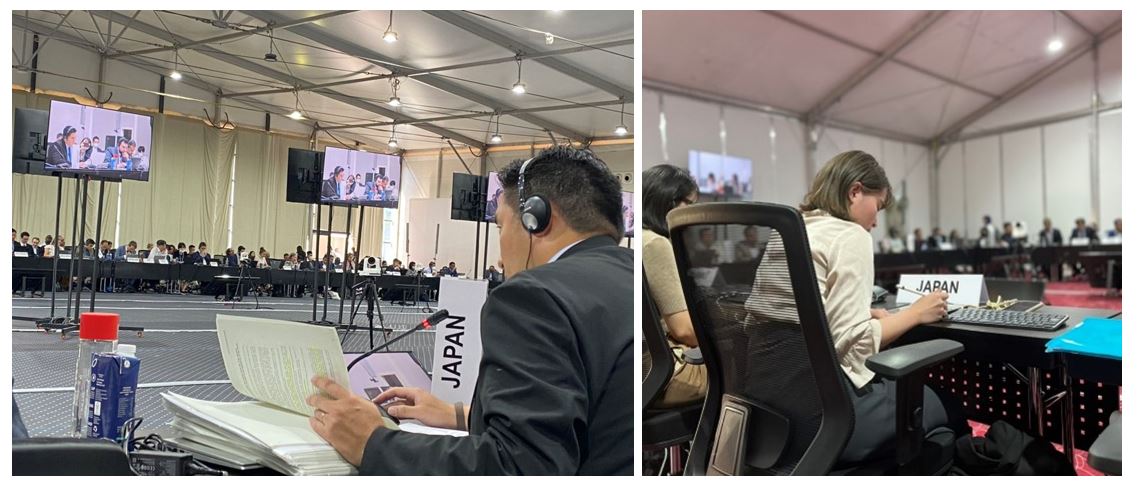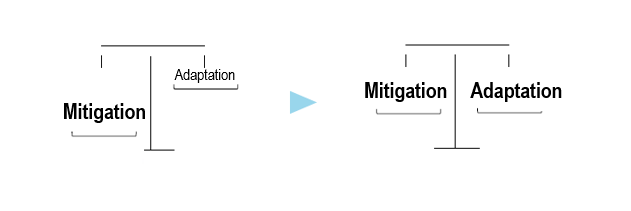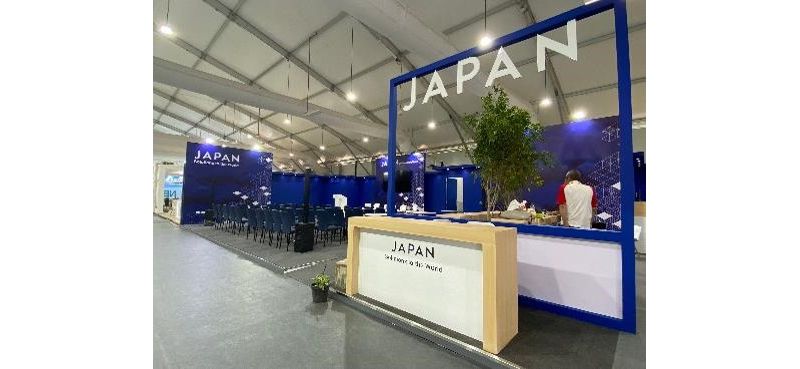COP28 is coming soon!
Let us review COP27 for a better understanding of COP28.
(in provisional translation)
(English ver.) 2024-01-24

Delegates from countries around the world will gather to discuss climate change at COP28, which will be held from November 30, 2023. To better understand COP28, it may be helpful to review the history of COPs in recent years with particular emphasis on what was discussed and determined at COP27, the most recent conference, held in November 2022.
Developments from COP21’s adoption of the Paris Agreement up to COP26
COP stands for the Conference of the Parties to the UN Framework Convention on Climate Change, where measures for reducing greenhouse gas (GHG) emissions and reduction targets are discussed. The Paris Agreement is an international treaty on climate change, which was adopted at COP21 in Paris, in 2015. Its overarching goal is to hold “the increase in the global average temperature to well below 2°C above pre-industrial levels and pursue efforts to limit the temperature increase to 1.5°C above pre-industrial levels.” “In order to achieve the long-term temperature goal, parties to the agreement aim to reach global peaking of GHG emissions as soon as possible, so as to achieve a balance between GHG emissions and removal of greenhouse gases (by forests and other means) in the second half of this century.” All parties to the agreement, including developing nations, are requested to make efforts to reduce their emissions. Each party is advancing efforts based on national climate action plans to achieve their Nationally Determined Contribution (NDCs).
Subsequent COPs have discussed detailed rulemaking. COP24 adopted a set of implementing guidelines for the Paris Agreement. As a result of intensive discussions at COP26 following COP25, nations reached new agreements for market mechanisms, essentially supporting the transfer of emission reductions between countries as credits, thereby finalizing the Paris Rulebook.
The graph below illustrates the ratios of the following three categories of negotiations:
- Rulemaking negotiations for the Paris Agreement at COP25, COP26, and COP27 in 2022
- Cover decision negotiations for summarizing comprehensive opinions and directions discussed at each COP
- Events/initiatives that include processes involving the leaders of respective countries
Generally, the ratio of rulemaking negotiations is declining as progress is being made year by year with less issues remaining. The ratios of cover decision negotiations and events/initiatives are increasing as climate change awareness is spreading to higher levels and wider arenas.
The conceptual ratios of rulemaking negotiations, cover decision negotiations and events/initiatives in recent COPs

After the finalization of the Paris Rulebook, COP27 discussed implementation
COP27, held in November 2022, focused on the implementation of climate change countermeasures. It was attended by leaders of about 100 countries across the world, including US President Biden, French President Macron, and German Chancellor Scholz. From Japan, Minister of the Environment Nishimura participated.

Scenes of the negotiation meeting
Keywords for understanding COP27 are mitigation, adaptation, and loss and damage. Mitigation refers to curbing GHG emissions to reduce climate change. Adaptation refers to preparations for preventing and abating climate change consequences that have already prevailed. It also refers to measures for utilizing new climate conditions, creating new trends giving serious consideration to such steps.
Balance between mitigation and adaptation

Loss and damage refers to the harm caused by global warming. As global warming progresses, there will be more natural disasters such as droughts, floods and typhoons, causing serious damage. Rising sea levels will also erode dry land. We need to take measures to prevent or reduce the impact of disasters and protect human health.
The Sharm el-Sheikh Implementation Plan adopted as an outcome of COP27 includes the following:
-
 The Plan recognizes the importance of implementing actions aligned with the 1.5°C goal.
The Plan recognizes the importance of implementing actions aligned with the 1.5°C goal.
-
 All parties should strengthen their strategies toward 2030 aligned with the 1.5°C goal.
All parties should strengthen their strategies toward 2030 aligned with the 1.5°C goal.
-
 Agreement was reached on the establishment of a fund responding to loss and damage from climate-induced disasters.
Agreement was reached on the establishment of a fund responding to loss and damage from climate-induced disasters.
The Mitigation Work Program was adopted to scale up mitigation ambition. The Program sets up a work cycle including at least two dialogues per year and the publishing of a report on annual progress to be presented to the Ministerial Roundtable. It targets all emission sectors and cross-cutting issues. The Program also involves non-governmental bodies.
For market mechanisms, detailed rules such as reporting formats and recording systems for transactions were determined, as well as procedures for experts to conduct examinations.
With regard to mitigation measures, progress in the two-year work program agreed upon at COP26 was confirmed, and discussions were held on how to proceed with the Program toward 2023.
The establishment of a loss and damage fund was included in the agenda for the first time in the history of the COP. New funding arrangements including this loss and damage fund were agreed upon to respond to the harm incurred by the nations most vulnerable to climate change. Details have yet to be determined at this point in time, and discussions will be held with a view to finalizing them at COP28. Moreover, organizational and systematic aspects of the promotion of technological support were also determined.
Initiatives led by Japan
In addition to the above, events/initiatives including the processes involving leaders of the respective countries were noteworthy.
MOE Minister Nishimura communicated the following initiatives at the Ministerial Level Session of COP27:
-
 Achieve GX investments upward of 150 trillion yen over the next ten years
Achieve GX investments upward of 150 trillion yen over the next ten years
-
 Launch a new nationwide initiative toward decarbonization
Launch a new nationwide initiative toward decarbonization
-
 Realize the Asia Zero Emission Community (AZEC) concept
Realize the Asia Zero Emission Community (AZEC) concept
Japan also announced a Loss and Damage Assistance Package to provide comprehensive technical support for disaster preparedness and relief, and the Paris Agreement Article 6 Implementation Partnership to promote the Joint Crediting Mechanism (JCM) as a market mechanism.
The Government of Japan also participated in international initiatives on climate change at COP27, including the Net-Zero Government Initiative led by the United States, and the Global Offshore Wind Energy Alliance jointly led by Denmark and the International Renewable Energy Agency (IRENA).
Throughout the conference period, Japan held seminars to communicate to the international community its efforts and technologies in areas such as hydrogen, offshore wind power, CO2 removal, decarbonization in hard-to-abate industries, and support for the transition to decarbonization.

A new concept of avoided emissions to evaluate corporate contributions to decarbonization was introduced. In the area of adaptation, Japan’s cooperation with the United Nations and Japanese companies’ contributions were presented. As an adaptation measure, a new Subaru Initiative was jointly announced by the UN-Habitat Fukuoka Headquarters and the Ministry of Economy, Trade and Industry, aiming to create climate-resilient cities in the Asia-Pacific region with the contributions from Japanese companies.

Points to note about COP28
COP28 will be held from November 30 to December 13, discussing measures for mitigation and loss and damage following the trends from COP27.
Furthermore, 2023 is the first year when the global stocktake is set to be conducted based on the Paris Agreement. The global stocktake is a process for countries and stakeholders to see where they are collectively making progress toward meeting the goals of the Paris Agreement and other long-term targets. It is to be conducted every fifth year, with 2023 being the first year. The United Arab Emirates (UAE) holds the presidency for COP28 and states that countries are expected to deliver important messages. We will keep an eye on what is happening there.
Divisions in Charge
About this article
Global environment Affairs Office, Industrial Science, Technology and Environment Policy Bureau, METI
About the Special Contents
Research and Public Relations Office, Commissioner’s Secretariat, ANRE
![]() The original Japanese text of this article; Click here
The original Japanese text of this article; Click here